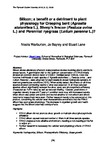Silicon: a benefit or a detriment to plant physiology for Creeping bent (Agrostis stolonifera L.), Sheep's fescue (Festuca ovina L.) and Perennial ryegrass (Lolium perenne L.)?
| dc.contributor.author | Warburton, N. | |
| dc.contributor.author | Bayley, J. | |
| dc.contributor.author | Lane, S. | |
| dc.date.accessioned | 2019-05-15T10:19:48Z | |
| dc.date.available | 2019-05-15T10:19:48Z | |
| dc.date.issued | 2012 | |
| dc.identifier.citation |
Warburton, N., Bayley, J., and Lane, S. (2012) Silicon; a benefit or a detriment to plant physiology for Creeping bent (Agrostis stolonifera L.), Sheep's fescue (Festuca ovina L.) and Perennial ryegrass (Lolium perenne L.)?, The Plymouth Student Scientist, 5(1), p. 79-93. | en_US |
| dc.identifier.issn | 1754-2383 | |
| dc.identifier.uri | http://hdl.handle.net/10026.1/13967 | |
| dc.description.abstract |
Silicon shows alleviatory effects in many previous studies involving abiotic and biotic stress factors. A germination trial for the optimum concentration of ERA-3 initially showed an optimum dilution factor of 2,500:1 (Distilled water: ERA-3). Over one hundred individuals of each species of Agrostis stolonifera L., Festuca ovina L. and Lolium Perenne L. were all grown for eight weeks in closed hydroponic systems, in warmed greenhouse conditions (15°C). When solely tested, the effects on all three species showed contrasting results to what was expected. In all three selected species, silicon significantly reduced the shoot area, and photosynthetic efficiency (measured as Fv/Fm ratio) as well as reduced tillering. However, predictions of organism density (mass unit-2) and pH condition were true, with increased density when silicon was added and acidic and neutral-alkaline for non-silicon and silicon treatments respectively were seen. Further research needs to be conducted on this product, concerning the cellular level characteristics and effects that the ERA-3 silicon has upon grass physiology. The decrease in organism growth and health suggest that the silicon used has toxicity effects. Highlights: ERA-3 silicon did not promote shoot growth or maintain shoot photosynthetic efficiency. ERA-3 silicon caused reduced number of tillers in all three sample species. ERA-3 creates a more alkaline environment, needing a non-reacting pH buffer to adjust pH. Further research is necessary into cellular level physiology effects of ERA-3 silicon. | en_US |
| dc.language.iso | en | en_US |
| dc.publisher | University of Plymouth | |
| dc.rights | Attribution 3.0 United States | * |
| dc.rights.uri | http://creativecommons.org/licenses/by/3.0/us/ | * |
| dc.subject | hydroponics | en_US |
| dc.subject | silicon | en_US |
| dc.subject | photosynthetic efficiency | en_US |
| dc.subject | grass growth | en_US |
| dc.subject | grass | en_US |
| dc.title | Silicon: a benefit or a detriment to plant physiology for Creeping bent (Agrostis stolonifera L.), Sheep's fescue (Festuca ovina L.) and Perennial ryegrass (Lolium perenne L.)? | en_US |
| dc.type | Article | |
| plymouth.issue | 1 | |
| plymouth.volume | 5 | |
| plymouth.journal | The Plymouth Student Scientist |



